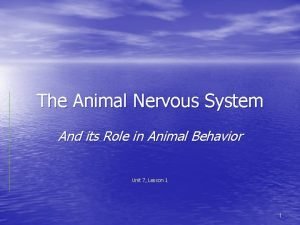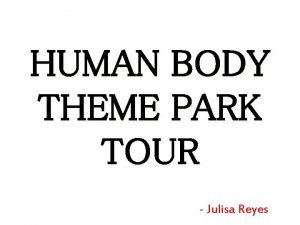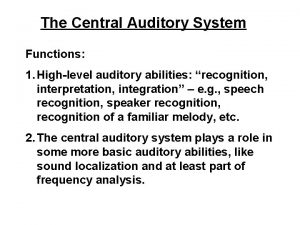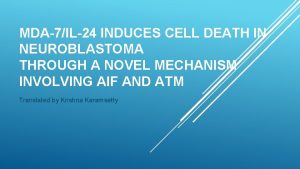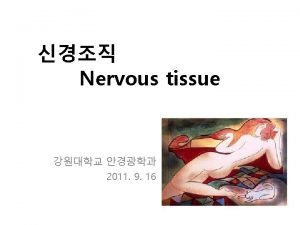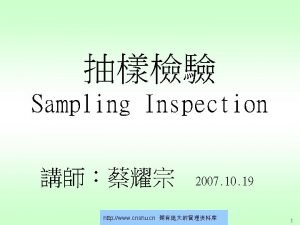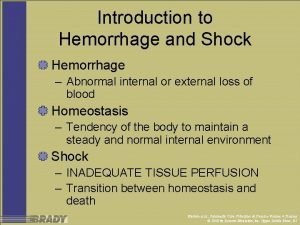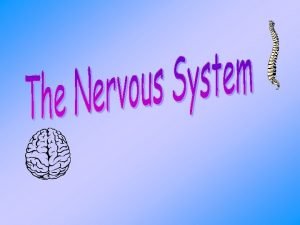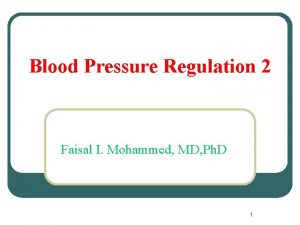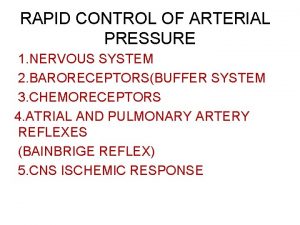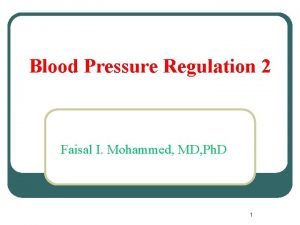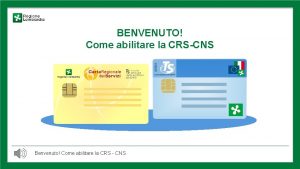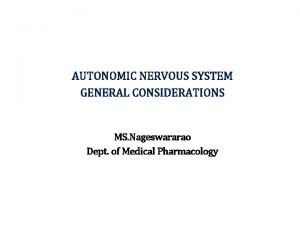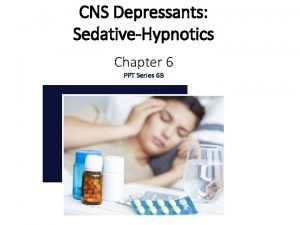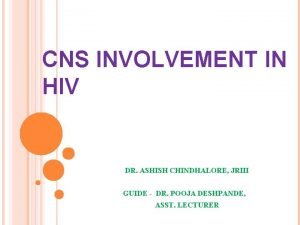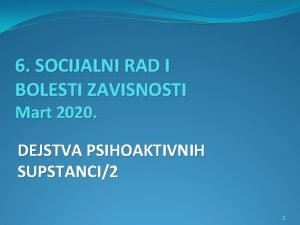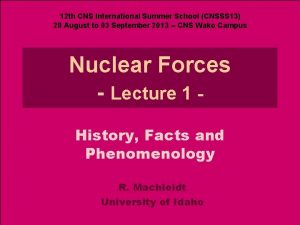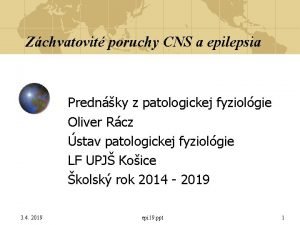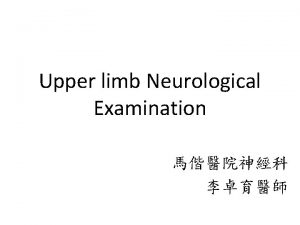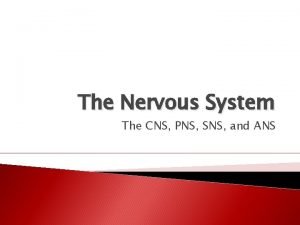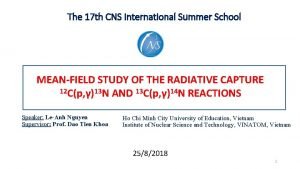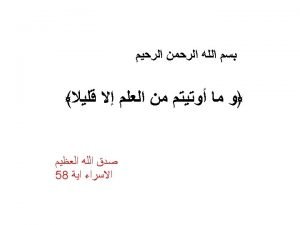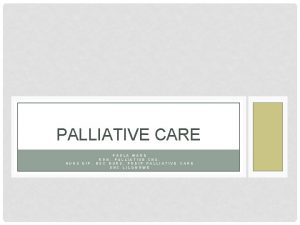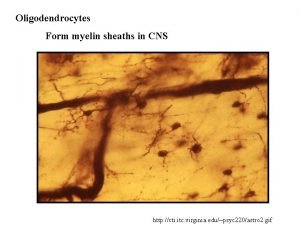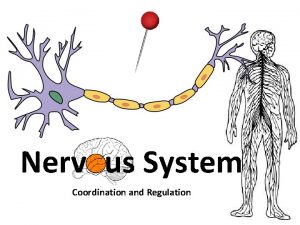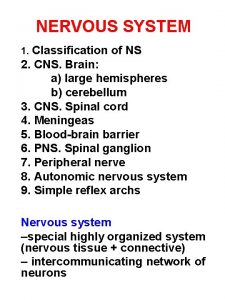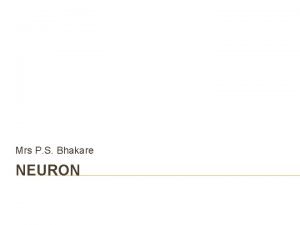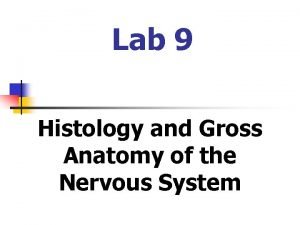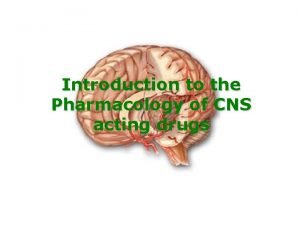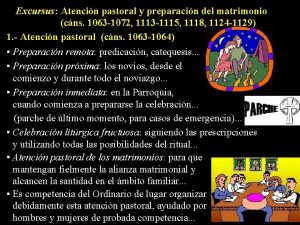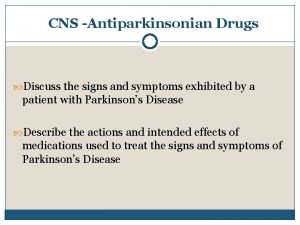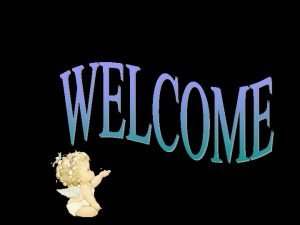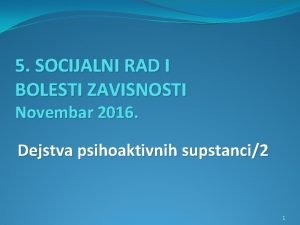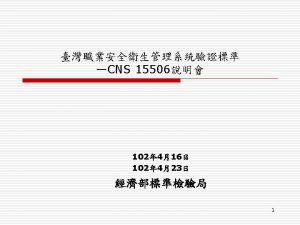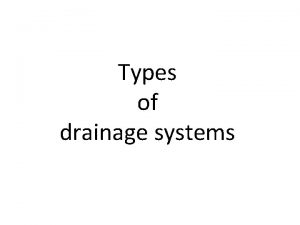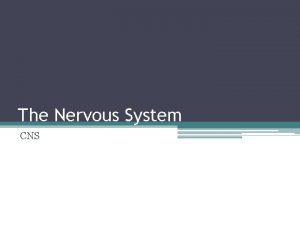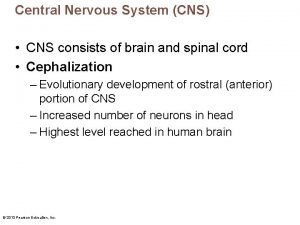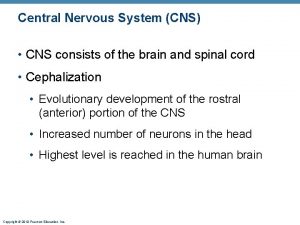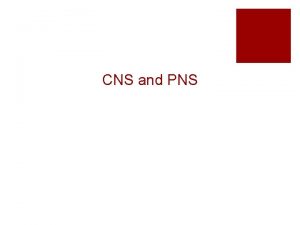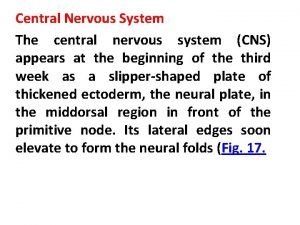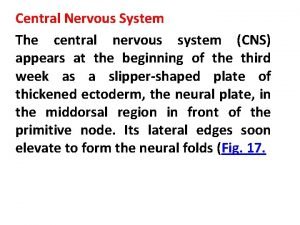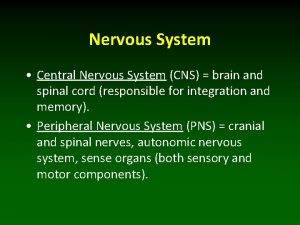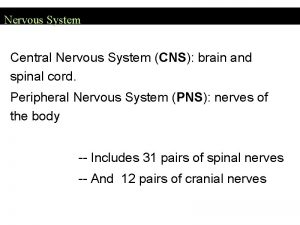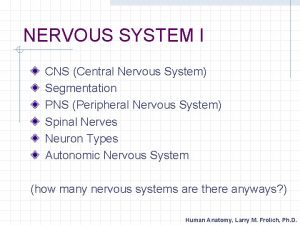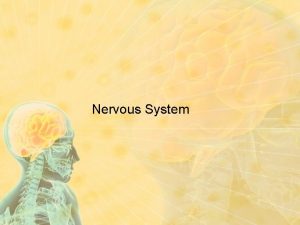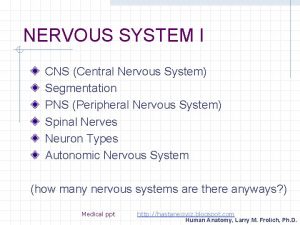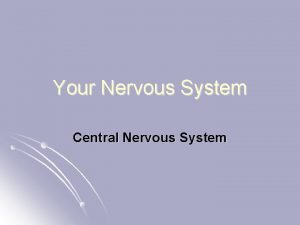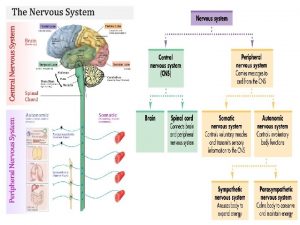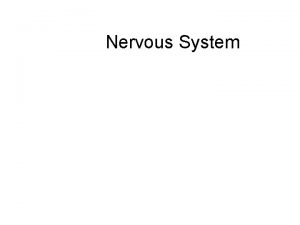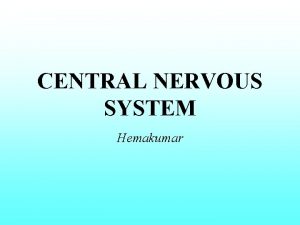Central Nervous System CNS CNS consists of the




















































- Slides: 52

Central Nervous System (CNS) • CNS consists of the brain and spinal cord • Cephalization • Evolutionary development of the rostral (anterior) portion of the CNS • Increased number of neurons in the head • Highest level is reached in the human brain

Embryonic Development • Neural plate forms from ectoderm • Neural plate invaginates to form a neural groove and neural folds

Regions and Organization of the CNS • Adult brain regions 1. Cerebral hemispheres 2. Diencephalon 3. Brain stem (midbrain, pons, and medulla) 4. Cerebellum

Cerebral hemisphere Diencephalon (d) Birth Cerebellum Brain stem • Midbrain • Pons • Medulla oblongata Figure 12. 3 d

Regions and Organization of the CNS • Spinal cord • Central cavity surrounded by a gray matter core • External white matter composed of myelinated fiber tracts

Regions and Organization of the CNS • Brain • Similar pattern with additional areas of gray matter • Nuclei in cerebellum and cerebrum • Cortex of cerebellum and cerebrum

Cortex of gray matter Inner gray matter Central cavity Migratory pattern of neurons Cerebrum Cerebellum Region of cerebellum Outer white matter Gray matter Central cavity Inner gray matter Outer white matter Brain stem Gray matter Central cavity Outer white matter Spinal cord Inner gray matter Figure 12. 4

Ventricles of the Brain • Connected to one another and to the central canal of the spinal cord • Lined by ependymal cells

Ventricles of the Brain • Contain cerebrospinal fluid • Two C-shaped lateral ventricles in the cerebral hemispheres • Third ventricle in the diencephalon • Fourth ventricle in the hindbrain, dorsal to the pons, develops from the lumen of the neural tube

Lateral ventricle Septum pellucidum Anterior horn Inferior horn Lateral aperture Interventricular foramen Third ventricle Inferior horn Cerebral aqueduct Fourth ventricle Central canal (a) Anterior view (b) Left lateral Posterior horn Median aperture Lateral aperture view Figure 12. 5

Cerebral Hemispheres • Surface markings • Ridges (gyri), shallow grooves (sulci), and deep grooves (fissures) • Five lobes • Frontal • Parietal • Temporal • Occipital • Insula

Cerebral Hemispheres • Surface markings • Central sulcus • Separates the precentral gyrus of the frontal lobe and the postcentral gyrus of the parietal lobe • Longitudinal fissure • Separates the two hemispheres • Transverse cerebral fissure • Separates the cerebrum and the cerebellum

Cerebral Cortex • Thin (2– 4 mm) superficial layer of gray matter • 40% of the mass of the brain • Site of conscious mind: awareness, sensory perception, voluntary motor initiation, communication, memory storage, understanding • Each hemisphere connects to contralateral side of the body • There is lateralization of cortical function in the hemispheres

Functional Areas of the Cerebral Cortex • The three types of functional areas are: • Motor areas—control voluntary movement • Sensory areas—conscious awareness of sensation • Association areas—integrate diverse information • Conscious behavior involves the entire cortex

Motor Areas • Primary (somatic) motor cortex • Premotor cortex • Broca’s area • Frontal eye field

Motor areas Central sulcus Primary motor cortex Premotor cortex Frontal eye field Broca’s area (outlined by dashes) Prefrontal cortex Working memory for spatial tasks Executive area for task management Working memory for object-recall tasks Solving complex, multitask problems (a) Lateral view, left cerebral hemisphere Sensory areas and related association areas Primary somatosensory cortex Somatic Somatosensory sensation association cortex Gustatory cortex (in insula) Taste Wernicke’s area (outlined by dashes) Primary visual cortex Visual association area Auditory association area Primary auditory cortex Vision Hearing Motor association cortex Primary sensory cortex Primary motor cortex Sensory association cortex Multimodal association cortex Figure 12. 8 a

Primary Motor Cortex • Large pyramidal cells of the precentral gyri • Long axons pyramidal (corticospinal) tracts • Allows conscious control of precise, skilled, voluntary movements • Motor homunculi: upside-down caricatures representing the motor innervation of body regions

Posterior Motor map in precentral gyrus Anterior Toes Jaw Tongue Swallowing Primary motor cortex (precentral gyrus) Figure 12. 9

Premotor Cortex • Anterior to the precentral gyrus • Controls learned, repetitious, or patterned motor skills • Coordinates simultaneous or sequential actions • Involved in the planning of movements that depend on sensory feedback

Broca’s Area • Anterior to the inferior region of the premotor area • Present in one hemisphere (usually the left) • A motor speech area that directs muscles of the tongue • Is active as one prepares to speak

Frontal Eye Field • Anterior to the premotor cortex and superior to Broca’s area • Controls voluntary eye movements

Sensory Areas • Primary somatosensory cortex • Somatosensory association cortex • Visual areas • Auditory areas • Olfactory cortex • Gustatory cortex • Visceral sensory area • Vestibular cortex

Motor areas Central sulcus Primary motor cortex Premotor cortex Frontal eye field Broca’s area (outlined by dashes) Prefrontal cortex Working memory for spatial tasks Executive area for task management Working memory for object-recall tasks Solving complex, multitask problems (a) Lateral view, left cerebral hemisphere Sensory areas and related association areas Primary somatosensory cortex Somatic Somatosensory sensation association cortex Gustatory cortex (in insula) Taste Wernicke’s area (outlined by dashes) Primary visual cortex Visual association area Auditory association area Primary auditory cortex Vision Hearing Motor association cortex Primary sensory cortex Primary motor cortex Sensory association cortex Multimodal association cortex Figure 12. 8 a

Primary Somatosensory Cortex • In the postcentral gyri • Receives sensory information from the skin, skeletal muscles, and joints • Capable of spatial discrimination: identification of body region being stimulated

Posterior Sensory Anterior Sensory map in postcentral gyrus Genitals Primary somatosensory cortex (postcentral gyrus) Intraabdominal Figure 12. 9

Somatosensory Association Cortex • Posterior to the primary somatosensory cortex • Integrates sensory input from primary somatosensory cortex • Determines size, texture, and relationship of parts of objects being felt

Visual Areas • Primary visual (striate) cortex • Extreme posterior tip of the occipital lobe • Most of it is buried in the calcarine sulcus • Receives visual information from the retinas

Visual Areas • Visual association area • Surrounds the primary visual cortex • Uses past visual experiences to interpret visual stimuli (e. g. , color, form, and movement) • Complex processing involves entire posterior half of the hemispheres

Auditory Areas • Primary auditory cortex • Superior margin of the temporal lobes • Interprets information from inner ear as pitch, loudness, and location • Auditory association area • Located posterior to the primary auditory cortex • Stores memories of sounds and permits perception of sounds

OIfactory Cortex • Medial aspect of temporal lobes (in piriform lobes) • Part of the primitive rhinencephalon, along with the olfactory bulbs and tracts • (Remainder of the rhinencephalon in humans is part of the limbic system) • Region of conscious awareness of odors

Gustatory Cortex • In the insula • Involved in the perception of taste

Visceral Sensory Area • Posterior to gustatory cortex • Conscious perception of visceral sensations, e. g. , upset stomach or full bladder

Vestibular Cortex • Posterior part of the insula and adjacent parietal cortex • Responsible for conscious awareness of balance (position of the head in space)

Multimodal Association Areas • Receive inputs from multiple sensory areas • Send outputs to multiple areas, including the premotor cortex • Allow us to give meaning to information received, store it as memory, compare it to previous experience, and decide on action to take

Multimodal Association Areas • Three parts • Anterior association area (prefrontal cortex) • Posterior association area • Limbic association area

Anterior Association Area (Prefrontal Cortex) • Most complicated cortical region • Involved with intellect, cognition, recall, and personality • Contains working memory needed for judgment, reasoning, persistence, and conscience • Development depends on feedback from social environment

Posterior Association Area • Large region in temporal, parietal, and occipital lobes • Plays a role in recognizing patterns and faces and localizing us in space • Involved in understanding written and spoken language (Wernicke’s area)

Limbic Association Area • Part of the limbic system • Provides emotional impact that helps establish memories

Lateralization of Cortical Function • Lateralization • Division of labor between hemispheres • Cerebral dominance • Designates the hemisphere dominant for language (left hemisphere in 90% of people)

Lateralization of Cortical Function • Left hemisphere • Controls language, math, and logic • Right hemisphere • Insight, visual-spatial skills, intuition, and artistic skills • Left and right hemispheres communicate via fiber tracts in the cerebral white matter

Cerebral White Matter • Myelinated fibers and their tracts • Responsible for communication • Commissures (in corpus callosum)—connect gray matter of the two hemispheres • Association fibers—connect different parts of the same hemisphere • Projection fibers—(corona radiata) connect the hemispheres with lower brain or spinal cord

Longitudinal fissure Lateral ventricle Basal nuclei • Caudate • Putamen • Globus pallidus Thalamus Superior Commissural fibers (corpus callosum) Association fibers Corona radiata Fornix Internal capsule Gray matter Third ventricle White matter Pons Projection fibers Medulla oblongata (a) Decussation of pyramids Figure 12. 10 a

Basal Nuclei (Ganglia) • Subcortical nuclei • Consists of the corpus striatum • Caudate nucleus • Lentiform nucleus (putamen + globus pallidus) • Functionally associated with the subthalamic nuclei (diencephalon) and the substantia nigra (midbrain)

Functions of Basal Nuclei • Though somewhat elusive, the following are thought to be functions of basal nuclei • Influence muscular control • Help regulate attention and cognition • Regulate intensity of slow or stereotyped movements • Inhibit antagonistic and unnecessary movements

Diencephalon • Three paired structures • Thalamus • Hypothalamus • Epithalamus • Encloses the third ventricle

Cerebral hemisphere Septum pellucidum Interthalamic adhesion (intermediate mass of thalamus) Interventricular foramen Anterior commissure Hypothalamus Optic chiasma Pituitary gland Mammillary body Pons Medulla oblongata Corpus callosum Fornix Choroid plexus Thalamus (encloses third ventricle) Posterior commissure Pineal gland (part of epithalamus) Corpora quadrigemina Mid. Cerebral brain aqueduct Arbor vitae (of cerebellum) Fourth ventricle Choroid plexus Cerebellum Spinal cord Figure 12. 12

Thalamus • 80% of diencephalon • Superolateral walls of the third ventricle • Connected by the interthalamic adhesion (intermediate mass) • Contains several nuclei, named for their location • Nuclei project and receive fibers from the cerebral cortex

Dorsal nuclei Medial Lateral dorsal posterior Pulvinar Anterior nuclear group Reticular nucleus Ventral posteroanterior lateral Medial geniculate body Lateral geniculate body Ventral nuclei (a) The main thalamic nuclei. (The reticular nuclei that “cap” the thalamus laterally are depicted as curving translucent structures. ) Figure 12. 13 a

Thalamic Function • Gateway to the cerebral cortex • Sorts, edits, and relays information • Afferent impulses from all senses and all parts of the body • Impulses from the hypothalamus for regulation of emotion and visceral function • Impulses from the cerebellum and basal nuclei to help direct the motor cortices • Mediates sensation, motor activities, cortical arousal, learning, and memory

Hypothalamus • Forms the inferolateral walls of the third ventricle • Contains many nuclei • Example: mammillary bodies • Paired anterior nuclei • Olfactory relay stations • Infundibulum—stalk that connects to the pituitary gland

Paraventricular nucleus Anterior commissure Preoptic nucleus Anterior hypothalamic nucleus Supraoptic nucleus Suprachiasmatic nucleus Fornix Arcuate nucleus Pituitary gland Optic chiasma Infundibulum (stalk of the pituitary gland) (b) The main hypothalamic nuclei. Dorsomedial nucleus Posterior hypothalamic nucleus Lateral hypothalamic area Ventromedial nucleus Mammillary body Figure 12. 13 b

Hypothalamic Function • Autonomic control center for many visceral functions (e. g. , blood pressure, rate and force of heartbeat, digestive tract motility) • Center for emotional response: Involved in perception of pleasure, fear, and rage and in biological rhythms and drives
 Autonomic nervous system consists of
Autonomic nervous system consists of Peripheral nervous system consists of
Peripheral nervous system consists of Youtub.eoc
Youtub.eoc What are the characteristics of nervous tissue
What are the characteristics of nervous tissue Fundamentals of the nervous system and nervous tissue
Fundamentals of the nervous system and nervous tissue Processes of neuron
Processes of neuron Nervous system major divisions
Nervous system major divisions Central nervous system amusement park
Central nervous system amusement park Part of central nervous system
Part of central nervous system Building vocabulary activity: the central nervous system
Building vocabulary activity: the central nervous system Nervous system of grasshopper
Nervous system of grasshopper Bser aer
Bser aer Neuroglia
Neuroglia Central nervous system for kids
Central nervous system for kids Nervous system and digestive system
Nervous system and digestive system Endocrine system vs nervous system
Endocrine system vs nervous system Endo crine gland
Endo crine gland Endocrine system and nervous system
Endocrine system and nervous system Central nervous sysytem
Central nervous sysytem Ltpd table
Ltpd table Naas cns
Naas cns Cns ischemic response
Cns ischemic response Nervous tissue ppt
Nervous tissue ppt Composition of cns
Composition of cns Cns ischemic response
Cns ischemic response Mean arterial pressure
Mean arterial pressure Bainbridge reflex
Bainbridge reflex Www.lispa.it cns
Www.lispa.it cns Ans and cns difference
Ans and cns difference Cns depressants ppt
Cns depressants ppt Cns
Cns Depresori cns
Depresori cns Cns international school
Cns international school Cns poruchy
Cns poruchy Neuro motor exam scale
Neuro motor exam scale Dermatome map
Dermatome map Neutron capture
Neutron capture Mesencephalon
Mesencephalon Cns ward
Cns ward Cns
Cns Structure of the reflex arc
Structure of the reflex arc Classification of ns
Classification of ns Soma cns
Soma cns Neuron histology
Neuron histology Classification of cholinergic drugs
Classification of cholinergic drugs Cns educar
Cns educar Soma cns
Soma cns Pagitane
Pagitane Cns-cp
Cns-cp Barbiturates classification
Barbiturates classification Depresori cns
Depresori cns Cns15506
Cns15506 One pipe system
One pipe system

